If you don’t work from embroidery kits or books, then you probably come up with your own designs. What inspires them? Throughout history, artists have taken their inspiration from many sources – from nature, from religion, from life and all aspects of life.
When it comes to embroidery and needlework, looking around at all the brilliant designers and stitchers out there, I often find myself somewhat dissatisfied with my comparative lack of inspiration. But there are a few things that do inspire me, and occasionally, there are those little moments when something bursts upon the eye and lights up the brain, screaming, “You want to embroidery me!” The fat robin outside my window right now… the frozen tulip in the corner of the yard, encased in late-season ice… the twiggy branch covered with pale green buds that’s scratching on my window; the design in the carpet at my feet; the colorful engravings on a piece of foreign currency… these things catch my eye, and I think they would make interesting subjects for embroidery.
But, to tell you the truth, that’s about as far as they go. They catch my eye, they spark my interest, they suggest a design. But they rarely materialize.
Why not, I wonder… Part of the answer lies in my lack of drawing ability. I would like to be able to draw better than I do. Stylized patterns and motifs are fine, but realistic sketching is not a skill I’ve remotely perfected. Another part of the answer (and probably the greater part) lies in a lack of concentration or focus on creating, due to the lack of time and the overabundance of other responsibilities. Without the “leisure” required to attend to artistic pursuits, it is difficult to hone in and take perception to fruition in a completed project – or at least to do so while the inspiration is vivid. In fact, it’s often difficult just to take the time to really see things and get inspired!
But inspiration doesn’t have to come from the “raw,” and, in fact, as far as actually working a project goes, I take more inspiration from other pieces of art – already done, already realized in another medium – than I do from nature or other raw sources.
I’d like to show you an example of what I mean. Lately, I’ve been musing and stewing over stumpwork. Do you know what it’s like when an idea, technique, or project begins to gnaw away at your imagination and consume all your thoughts? That’s how I’ve been about stumpwork lately. You’ve actually seen some of the consequences of this stumpwork obsession in my recent posts – my re-awakened interest in the Plimoth Plantation jacket project; the kits I posted the other day; the links to Thistle Threads (with that beautiful museum-licensed box project!); Jane Nicholas’s Stumpwork Embroidery book review; the book review on Embroidered Flora & Fauna – all of these posts are related to my recent stewings!
More than anything else, though, two books that are not embroidery books have occupied my mind. I’m not writing a book review here! Rather, I want to show you how one art form can directly inspire ideas for another.
This isn’t a new connection, though. Illumination (painting or drawing to embellish a written work) and embroidery have developed side-by-side throughout history. But take a look at these two books on illumination, and you’ll see where my thoughts are going as far as stumpwork is concerned.
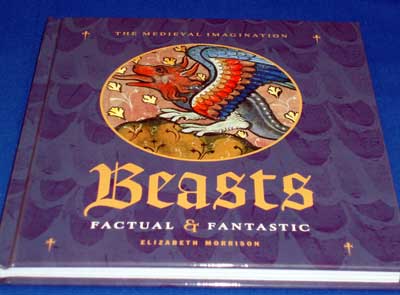
The first book here is Beasts Factual and Fantastic by Elizabeth Morrison. This is a beautiful little book full of colored photographs of different illuminated works throughout history. The author concentrates on the animals (both the realistic and the fantastic) in illuminated manuscripts and books. From bunnies to bears to gargolyes and strange mixed breeds, somehow, they all found their way into illumination.
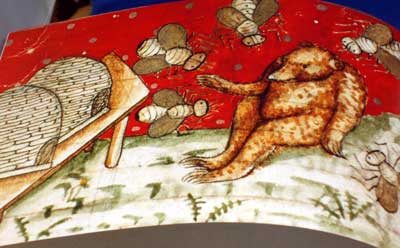
This picture in particular captures my embroidering fancy. The bear is a study for padding and French knots. The hives, for couched gold on felt padding. The monster bees, perfect for turkey work and wire wings. Further additions of flowers and grasses could cheer the scene up a bit. While there’s something about the picture that borders on grotesque – the long claws of the bear, the more “human-like” form of his body, the insanely disproportioned bees – there’s also something charming about it, and it could be made really charming with the addition of a little brightness. I like it! It’s morphing about in my mind! Will it result in anything finished? I don’t know yet!
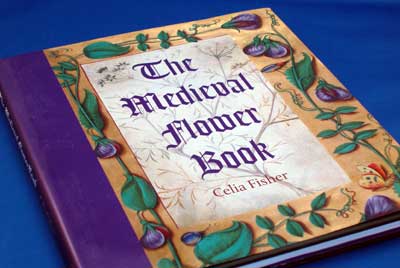
The second book is The Medieval Flower Book by Celia Fisher. This book explores in particular flowers as embellishments of manuscripts and books.
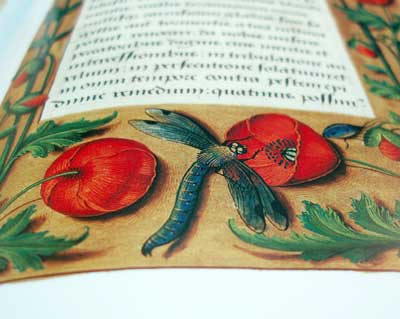
The close association between illumination and stumpwork can certainly be seen here. I love this dragonfly and the bright red poppies.
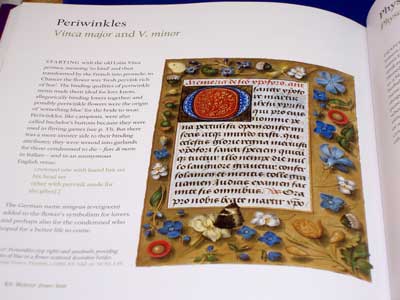
Again, another illumination that begs for a stumpwork interpretation! The blue flowers, the thistles, the butterflies, and the little hairy petals that surround the painted pearls are all perfect for interpretation in embroidery.
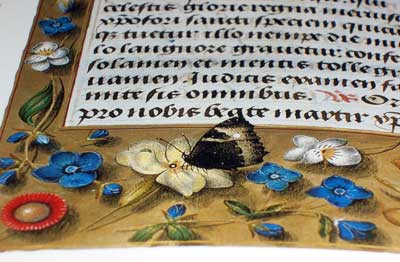
It’s funny how, when looking at the page on slant, the butterfly is so perfectly rendered that its wings seem to be lifted up off the page!
These two books have provided my night-time reading lately, as well as my lunch-time book browsing. When I see something I particularly like, I note it down or put a marker in the book, so I can come back to it later and consider it from the point of view of the embroiderer.
Inspiration can come from anywhere, really. Right now, mine is definitely coming from a variety of books that I’ve been reading. As the weather warms up, perhaps there will be more of an opportunity to get inspired outside, but in the meantime, I’m completely besotted with these two books and the ideas they’re fueling in my head!
What inspires you?







Anything and everything! Scenes or “shots” in a movie, architecture, nature, shadows, splotches. I was watching a movie last night and some of the photographic shots were out of this world – bold splashes of color: white sand, red/orange hills and shocking blue sky, or blue house tops seen from a geometric wall. It makes me want to grab my color pencils and remember it in my journal.
Wow. I’m pretty much diametrically opposite in method to you, which surprises me not a whole lot. You’re quite precise and like to get it ‘right’–I just look at things and go, “I can do that freehand.”
And I do. It’s not as exact or true to life as many folks’ work may be, but it’s fun and comes out looking more or less as I had in mind, and isn’t that the point?
Anything can be an inspiration. A pattern, a memory, a slight tweak on reality, or just the thread I happen to have on hand!
I’d never have associated the pictures you cite with stumpwork, though I can see how it might work for someone so inclined… 🙂
Oh, well. Now that it’s summer, I’m pretty much gardening and spinning–and my hands will be too rough for even that soon!
(Hi Mary – this comment became an e-mail and have so many links …as you’ll read it before editing please don’t and consider it an e-mail:)
I’m a basic embroiderer, as you know. I use to see some magazines and the inspiration comes from them, more or less.
The few things I’ve embroidered usualy are not simetrical and have simple shapes (i’m not good at drawing); as you can see here:
http://www.flickr.com/photos/92287635@N00/2249201996/
I began without plan and stopped when I thought it was enough: sometimes I adjust a magazine design:
http://www.flickr.com/photos/92287635@N00/3337854771/
But since I found your blog the fact is I look at things around me in a different way even in museums, art exhibitions but one thing that catches my eye is cast iron work(?) used in gates, doors, balconies (there are lots of them the place I live)- a while ago you have talk about, I think – and art nouveau make me dream too 🙂
Thinking about this I think that under your influence I’ve progress (?) improve(?) from this:
http://www.flickr.com/photos/92287635@N00/2680030460/ to this
http://www.flickr.com/photos/92287635@N00/2809264244/
Thanks, Mary! Thanks a lot!
I’m with you – I can’t draw worth a darn, even after taking drawing lessons for two years. I express my creativity by using the designs of others and using my own threads in colors of my choosing. I often finish a project in a different way than the original pattern calls for.
Most of my embroidery I make for presents, so I start by thinking of the taste of the person the embroidery is for. I can’t draw or paint, so Google Image search is my friend.
When I find an image I like I either Gimpshop it to the right size, print it out and trace it (even a fairly dodgy image will normally do, as the original is normally just the starting point).
Or, more recently I have discovered it is easier to simply tape the tracing paper to the monitor, enlarge or reduce the image to the size desired, and then transfer to the fabric.
I figure that by the time it has been turned into an embroidery it is sufficiently different from the original to circumvent any copyright issues especially as these are one off pressies.
My current project is a silk shading rendition of a 50s tattoo design of a swallow.
Hi, Meri! The links are fantastic, and I think everyone will enjoy seeing your work! Thanks so much for sending them!
Sweet P, I’m glad I’m not the only one! 🙂
Yep, Google images is a good place to find interesting pictures – that’s how I find photos, for example, of flowers that I want to check the shading on, etc.
Thanks for your comments and insights, everyone!
MC
I take inspiration from many things – nature, the shapes and lines of buildings or pavement, my cats – pretty much anything. Like you, I am not as good a sketcher as I’d like to be. The way I get around that is to carry a camera with me everywhere (currently the one in my phone), and take pictures of anything that triggers inspiration. Later I can print them out (on regular paper to keep the cost down), lay tracing paper over it, and trace the elements that caught my attention.
I have never used a kit so far. At the moment I approach things a completely different way and it doesn’t even sound like ‘inspiration’ compared with what everyone else is doing here. I think about an object I want to produce, whether a scissors case, a hand towel, a sampler, etc, and then I think about what techniques I want to learn and what stitches I want to use. Then I think about what motifs or designs to apply and then the colors. Because I am currently living in Istanbul I have set myself the task of learning as much as I can about Turkish and Middle Eastern needlework in the time I am here so I almost always use those techniques, typical stitches, motifs and colors, but somehow they always end up with a sort of “Anglo-twist”. (You have no idea how very loveable stem stitch becomes when you ban yourself from using it!) Anyway, I try to balance a sort of ‘inner trajectory’ (ie what am I learning here?) with an outer demand not to be ‘wasteful’ (very important to Turkish women – wastefulness a big SIN!) so the thing is better if it’s ‘useful’ in some way. My (arbitrary) ‘rules’ give me discipline and a sense of progress and direction so I have a list of plans and notes to come to fruition. Another thing is, on occasion if I trial something small and it comes out rather wonky, I start from the beginning and make another one. How can I say I learned something if the end result isn’t there to see?